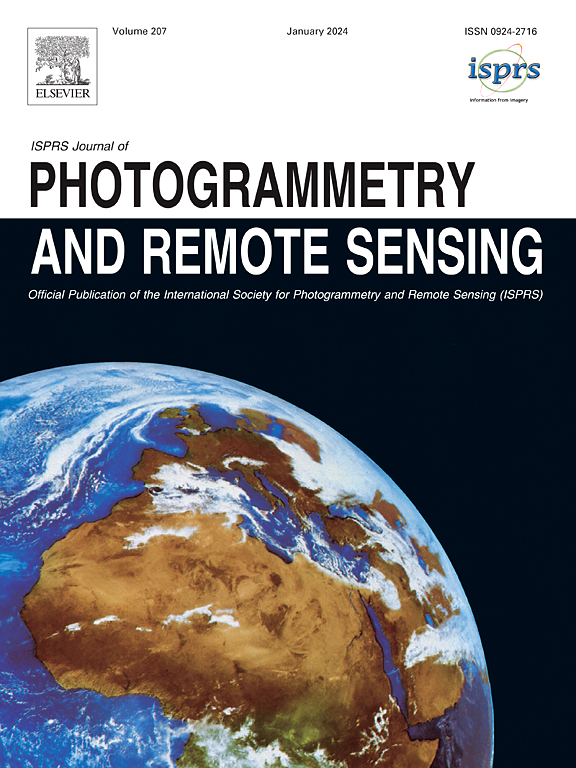地形点云变化估计的位置和方向联合图比较
IF 10.6
1区 地球科学
Q1 GEOGRAPHY, PHYSICAL
ISPRS Journal of Photogrammetry and Remote Sensing
Pub Date : 2024-11-29
DOI:10.1016/j.isprsjprs.2024.11.016
引用次数: 0
摘要
三维地形点云变化估计为理解地球表面过程动力学提供了基本输入。一般来说,变化估计的目的是检测尽可能多的具有显著性的点(即差异>;不确定性)和量化多种类型的地形变化。然而,点云数据的非均匀性、位置变化的高度不确定性以及不同类型的量化差异等复杂因素,对三维地形变化的可靠检测和量化提出了挑战。为了解决这些局限性,本文提出了一种基于图比较的方法来估计点云的三维地形变化。首先,针对地形点云的无序和非结构化特性,设计了一个具有位置和方向表示的图来聚合地形点云的局部邻居。其次,识别和比较两种地形点云之间的对应图,以量化位置和方向特征的差异和相关不确定性。特别是,该方法将两个特征(即位置和方向)的显著变化结合起来,并捕获每个显著变化点的位置差异(即距离)和方向差异(即旋转)。我们在一个山区(奥地利蒂罗尔的Sellrain)测试了所提出的方法,该山区覆盖了三对机载激光扫描点云,这些点云具有不同的点密度和复杂的地形变化,间隔时间为4年、6年和10年。我们的方法检测到91.39% ~ 93.03%的研究区域发生了显著变化,而最先进的方法(即多尺度模型到模型云比较,M3C2)在同一区域发现了36.81% ~ 47.41%的显著变化。特别是对于不变的建筑物屋顶,我们的方法测量的变化幅度低于M3C2。在浅层滑坡的情况下,我们的方法通过分析距离或旋转的变化,从总共88个参考滑坡中识别出84个。因此,我们的方法不仅可以检测到大量的显著变化,而且可以量化两种地形变化(即距离和旋转),并且对配准误差具有更强的鲁棒性。它显示了估计和解释自然环境中地形变化的巨大潜力。本文章由计算机程序翻译,如有差异,请以英文原文为准。
Location and orientation united graph comparison for topographic point cloud change estimation
3D topographic point cloud change estimation produces fundamental inputs for understanding Earth surface process dynamics. In general, change estimation aims at detecting the largest possible number of points with significance (i.e., difference uncertainty) and quantifying multiple types of topographic changes. However, several complex factors, including the inhomogeneous nature of point cloud data, the high uncertainty in positional changes, and the different types of quantifying difference, pose challenges for the reliable detection and quantification of 3D topographic changes. To address these limitations, the paper proposes a graph comparison-based method to estimate 3D topographic change from point clouds. First, a graph with both location and orientation representation is designed to aggregate local neighbors of topographic point clouds against the disordered and unstructured data nature. Second, the corresponding graphs between two topographic point clouds are identified and compared to quantify the differences and associated uncertainties in both location and orientation features. Particularly, the proposed method unites the significant changes derived from both features (i.e., location and orientation) and captures the location difference (i.e., distance) and the orientation difference (i.e., rotation) for each point with significant change. We tested the proposed method in a mountain region (Sellrain, Tyrol, Austria) covered by three airborne laser scanning point cloud pairs with different point densities and complex topographic changes at intervals of four, six, and ten years. Our method detected significant changes in 91.39 % − 93.03 % of the study area, while a state-of-the-art method (i.e., Multiscale Model-to-Model Cloud Comparison, M3C2) identified 36.81 % − 47.41 % significant changes for the same area. Especially for unchanged building roofs, our method measured lower change magnitudes than M3C2. Looking at the case of shallow landslides, our method identified 84 out of a total of 88 reference landslides by analysing change in distance or rotation. Therefore, our method not only detects a large number of significant changes but also quantifies two types of topographic changes (i.e., distance and rotation), and is more robust against registration errors. It shows large potential for estimation and interpretation of topographic changes in natural environments.
求助全文
通过发布文献求助,成功后即可免费获取论文全文。
去求助
来源期刊

ISPRS Journal of Photogrammetry and Remote Sensing
工程技术-成像科学与照相技术
CiteScore
21.00
自引率
6.30%
发文量
273
审稿时长
40 days
期刊介绍:
The ISPRS Journal of Photogrammetry and Remote Sensing (P&RS) serves as the official journal of the International Society for Photogrammetry and Remote Sensing (ISPRS). It acts as a platform for scientists and professionals worldwide who are involved in various disciplines that utilize photogrammetry, remote sensing, spatial information systems, computer vision, and related fields. The journal aims to facilitate communication and dissemination of advancements in these disciplines, while also acting as a comprehensive source of reference and archive.
P&RS endeavors to publish high-quality, peer-reviewed research papers that are preferably original and have not been published before. These papers can cover scientific/research, technological development, or application/practical aspects. Additionally, the journal welcomes papers that are based on presentations from ISPRS meetings, as long as they are considered significant contributions to the aforementioned fields.
In particular, P&RS encourages the submission of papers that are of broad scientific interest, showcase innovative applications (especially in emerging fields), have an interdisciplinary focus, discuss topics that have received limited attention in P&RS or related journals, or explore new directions in scientific or professional realms. It is preferred that theoretical papers include practical applications, while papers focusing on systems and applications should include a theoretical background.
 求助内容:
求助内容: 应助结果提醒方式:
应助结果提醒方式:


